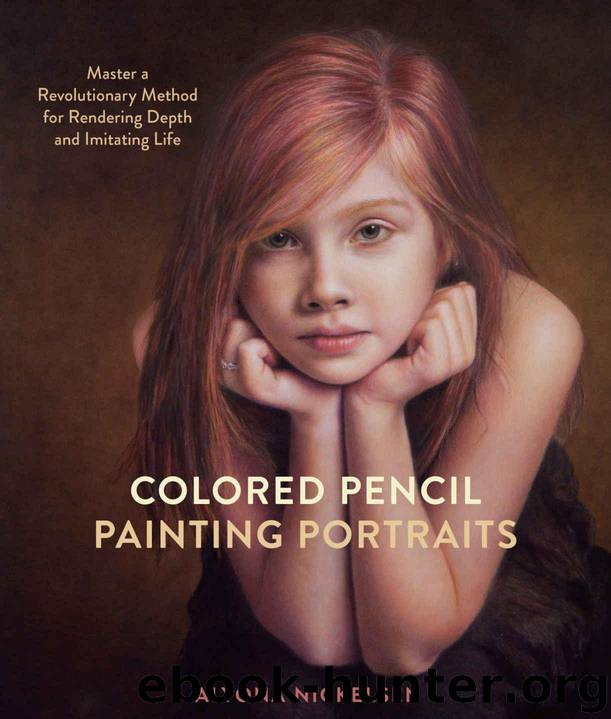Colored Pencil Painting Portraits: Master a Revolutionary Method for Rendering Depth and Imitating Life by Nickelsen Alyona

Author:Nickelsen, Alyona [Nickelsen, Alyona]
Language: eng
Format: azw3, epub
Publisher: Potter/TenSpeed/Harmony
Published: 2017-06-20T04:00:00+00:00
This type of information can be utilized in the artwork with assurance of accuracy as long as the reference was not distorted during its creation or software modification.
Due to the nature of lenses, all photo references contain optical distortions. These distortions create deformation of the image by stretching it, squishing it, or both (called “barrel,” “pincushion,” and “wave” optical distortions, respectively). Distortions are mostly noticeable at the edges of the frame in wide-angle lenses. In portraiture, optical distortions can cause the head to look larger than it is in reality and create the effect of bulging noses and tiny ears. One way to help avoid distortion is to not shoot your portraits with a wide-angle lens. To minimize distortion, use 50 mm lenses and above.
One common type of photographic image deformation is called “perspective distortion.” It occurs when the subject is too close to the lens, which makes him or her appear too large or distorted compared to the background, with such things as large noses compared to the rest of the head, huge hands and feet compared to the rest of the body, and the like. Perspective distortion also occurs when the camera is not parallel to the plane of the subject closest to it. This will cause the horizon not to be horizontal, and vertical lines, such as building structures or trees, to appear to lean. To avoid this type of image distortion, place the subject in the center of the frame, keep the lens parallel to the subject, and move a few feet back. Of course, the resolution of the camera must be high enough to allow you to crop the image and still be able to enlarge it so that you can clearly see the details of the facial features.
The colors presented in the reference should be treated with caution since they will seldom be true. This is due to the calibration of the camera, computer monitor, and printer, as well as the properties of ink and paper when the reference is actually printed. If the true appearance of colors is important for the final artwork, artists should create a set of color swatches using the same medium as the final artwork and accompany it with informational notations (eye color, hair color, dress color, and so on) and the colors that must be used to create them. In this manner, the photo reference can provide the approximate coloration and the artist can easily adjust hue, value, and intensity based on the color swatches and notes to achieve maximum accuracy.
A good photo reference for portraiture must provide you with a clear view of the face and show the eyes in focus. You should also be able to see the details in the shadows and in the most illuminated areas. If it is not possible to achieve this with a single shot, you can create three versions of the same image—overexposed, normally exposed, and underexposed—so that you can see the details in the extremes of the value range.
The
Download
Colored Pencil Painting Portraits: Master a Revolutionary Method for Rendering Depth and Imitating Life by Nickelsen Alyona.epub
This site does not store any files on its server. We only index and link to content provided by other sites. Please contact the content providers to delete copyright contents if any and email us, we'll remove relevant links or contents immediately.
Adulting by Kelly Williams Brown(4235)
Drawing Cutting Edge Anatomy by Christopher Hart(3290)
Figure Drawing for Artists by Steve Huston(3272)
Draw Your Day by Samantha Dion Baker(3127)
Drawing Shortcuts: Developing Quick Drawing Skills Using Today's Technology by Leggitt Jim(2940)
Make Comics Like the Pros by Greg Pak(2758)
Rapid Viz: A New Method for the Rapid Visualization of Ideas by Kurt Hanks & Larry Belliston(2729)
Draw to Win: A Crash Course on How to Lead, Sell, and Innovate With Your Visual Mind by Dan Roam(2639)
How Proust Can Change Your Life by Alain De Botton(2613)
How The Mind Works by Steven Pinker(2612)
0041152001443424520 .pdf by Unknown(2597)
Day by Elie Wiesel(2593)
Draw-A-Saurus by James Silvani(2504)
Modern Cartooning by Christopher Hart(2495)
Tattoo Art by Doralba Picerno(2488)
Poses for Artists Volume 2 - Standing Poses: An essential reference for figure drawing and the human form. (Inspiring Art and Artists) by Justin Martin(2441)
Learn Drawing Quickly by Sharon Finmark(2414)
Poses for Artists - Dynamic & Sitting: An essential reference for figure drawing and the human form (Inspiring Art and Artists Book 1) by Justin R Martin(2356)
Drawing and Painting Birds by Tim Wootton(2335)
